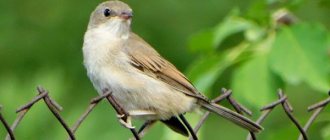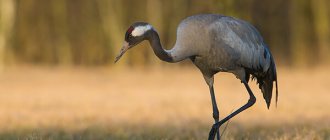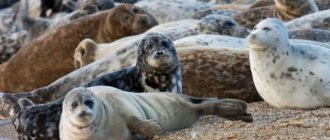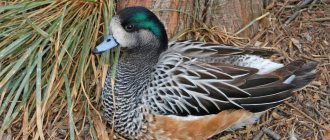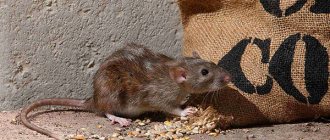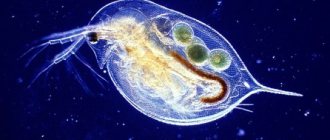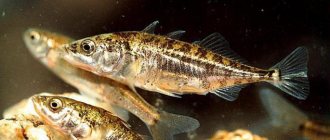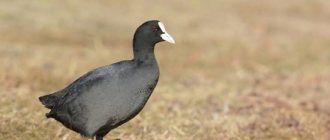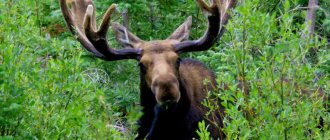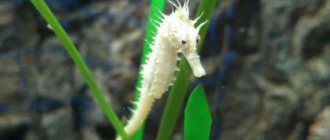The coot, or lyska (a black duck with a white beak) is a small waterfowl of the rail family, widely distributed over a vast territory of Eurasia, North Africa and Australia.
Within its range, it is well recognized by its white beak and white leathery plaque on its forehead. Local names for coot: kashkaldak (in the Lower Volga region, Kazakhstan, and Azerbaijan), kachkaldak (in the Caucasus and Turkmenistan).
In southwestern Spain and Morocco, you can find a similar species of coot - the crested coot (Fulica cristata); the latter has two red leathery balls on top of the plaque. Coots spend most of their time on the water, which makes them different from other rails.
Description
What it looks like, photo:
As has already become clear, the name of a duck with a white beak is coot. The breed belongs to the Shepherd family and the Crane-like order. The coot lives in water and is considered a small bird.
It has a bright, well-recognized appearance: black color, white leathery patch on the forehead and a white beak.
In addition to its usual name, it also has other territorial names: kachkaldak and kashkaldak. In appearance, the coot is similar to a medium-sized wild bird.
But still it differs from other types of ducks. For example, when swimming, coots lower their tails into the water. In addition, they do not have real membranes on their paws.
In addition to the question of what a black duck with a white beak is called, many are also interested in its characteristics:
- Body length - 36-38 centimeters.
- The wingspan is 19.5-23.5 centimeters.
- Weight is on average one kilogram, some individuals can reach a weight of 1.5 kilograms.
- The head is medium in size, with a white leathery growth on the forehead.
- Small white beak, compressed at the sides.
- Eyes with bright red irises.
- The body is knitted, strong, slightly flattened on the sides.
- The tail is short, the feathers on it are soft.
- The paws are yellowish-orange, the toes are gray.
- There are no membranes on the paws, but each toe has some kind of blades along the edges that help swim in the water.
- The color ranges from dark gray to black, the chest and belly are slightly lighter, smoky gray. Young black ducks have brown plumage with a grayish throat and belly.
It is worth noting that the name of a black duck with a white beak sounds different among people. Hunters and lovers of wild birds call them bald hens or water hens.
Sex differences
Sexual differences in the coot are weakly expressed. Drakes are slightly larger than ducks and also have a larger growth on their forehead. In terms of genetics and appearance, the black duck is closest to the moorhen.
Sometimes these species combine, resulting in hybrid offspring. Such babies have characteristics of both types of ducks, and the growth on the forehead is not white (like coots) or bright red (like moorhens), but orange.
Two-colored birds
Black white breasted
One of the brightest representatives of two-colored ducks is the Black White-breasted Duck. This breed is known for its dietary meat and beautiful appearance. These black ducks have a large body and are not at all fussy to care for. Russian poultry farmers are very fond of white-breasted birds and breed them in large numbers.
These black ducks were bred as a meat breed by crossing the Ukrainian White-breasted duck with the Peking duck and the Khaki Cambel in Ukraine. These birds have a deep chest and a wide and long back. The dominant color of the plumage is black, and there are white inserts on the chest in the form of a tailcoat. They are also present on the belly and slightly on the slightly raised tail. Black ducks have short legs, large dark eyes, a slightly concave small beak of a dark color, and the wings fit tightly to the back.
Sexual maturity in birds occurs at 6 months. The live weight of the female individual is 3-3.5 kg. A drake can weigh 3.5-4 kg. Black white-breasted ducks fatten quickly and well. By 2.5 months the weight of the young reaches 1.5-1.6 kg.
Features of Black White-breasted Birds:
- fast growth;
- ease of care;
- egg production – 120-130 eggs per year;
- beautiful appearance;
- good meat productivity;
- dark beak;
- calm character.
Mulard
The birds do not give birth, but are bred as a tasty source of meat. In European countries, a very popular dish made from Mulard's liver is foie gras.
The birds look majestic. The plumage of the Mulatto is white; a distinctive feature of the birds is small black spots on the head. Mulards are a mixture of Peking duck and Muscovy drake. This breed was bred quite recently and is used mainly only to produce tasty meat and valuable fatty liver.
Birds are not fertile at all. But how do offspring appear? Only by crossing.
Mulards are balanced and clean. Hybrid ducks have a wide back, medium-length paws of bright orange color and the same beak. Their eyes are shiny and black. By 1.5 months, the weight of the bird can reach 1.3-1.5 kg.
Features of Mulards:
- precocity;
- ease of care;
- quick adaptation to any climate;
- good egg production;
- sterility;
- beautiful coloring;
- high meat productivity;
- quick fattening;
- need for large amounts of water;
- wide body;
- big head.
Where can I meet you?
It is worth knowing not only what the black duck with a white beak is called, but also where it can be found. The bird lives in the territories of Eurasia and Africa.
Also, its nesting sites are present in all European countries, except for the highlands of Scandinavia and the northernmost points. It is worth noting that rare arrivals were observed in Greenland, on the islands of Labrador, Spitsbergen, and the Faroe Islands.
In Russia, the breed is distributed in Karelia and Lake Ladoga, in the Lena basin, throughout Siberia, the Far East and Sakhalin.
In Asia, the black duck with a white head and white beak lives in its middle part and in Kazakhstan, as well as in the northern regions of Pakistan, Afghanistan, partly in India, Mongolia, Bangladesh, China, the Philippines and Myanmar. The coot can be found on many islands of Oceania, Indonesia, New Zealand and Australia.
The black duck is also common in some African countries; it flies there for the winter from European countries with cold or temperate climates.
FEATURES OF THE RED-HEADED DIVERS
Flight: Before take-off, the red-headed duck needs a slight acceleration through the water. In flight, the long neck and short tail of the duck are clearly visible.
Body: massive, rounded, with a low landing on the water.
Legs: like all ducks, they are carried far to the end of the body - this improves swimming in water, but interferes with movement on land.
Duck: gray-brown, the boundaries between different colored areas of the body are the same as in the male. The beak is one-color, black.
Drake: It is difficult to confuse it with a duck of another species. The American diver has yellow eyes instead of red, and the royal diver is much larger and heavier.
— Nesting sites — Wintering sites
WHERE DOES IT LIVE?
In Eurasia from Portugal to Lake Baikal and a little further to the east. Small populations live in Iceland and Turkey.
Habitat and life expectancy
The coot is considered a classic waterfowl that rarely goes onto land and even nests in shallow water. The black wild duck prefers slightly salted or fresh water bodies with a slight current, and for nesting it chooses areas with dense vegetation on the shore.
Ducks live in lakes, lowland rivers, swamps, estuaries, sea bays and deltas. It is worth noting that wild ducks feel good near human habitation if they are not shot and fed. But they prefer to nest away from people.
Natural enemies of ducks are considered to be magpies and crows that steal eggs and chicks, marsh harrier, eagles, golden eagles and falcons. Nests can be destroyed by otters, minks, foxes, ferrets and weasels.
The coot is well protected by water from predators that live on land. When attacked, the duck creates a lot of splashes and defends itself with its white beak and wings.
The life expectancy of this breed in the wild is from 15 to 18 years.
How to cook coot meat
Most hunters do not pluck the bald ones dry, but rather rip off the skin directly with the feathers. Indeed, it is very difficult to pluck out the feathers of the eelgrass, since the skin tears easily. And by stripping, you can also get rid of the strong smell of mud that subcutaneous fat has. Removing the skin is quite simple - you need to make a longitudinal cut in the middle of the back and around the neck. The head, wing tips and paws are also removed. It is not recommended to use fat for cooking. If the bird is cleaned correctly, there will be no smell.
Marinade for coot meat
After cleaning and gutting the coot carcass, soak it in salted water for 3-4 hours and then marinate. The ingredients are as follows: a glass of apple cider vinegar or any fruit vinegar, or you can take a glass of dry red wine, boil with a teaspoon of salt, finely chopped roots and spices, cool and pour the carcass divided into 4 parts. Marinate for at least 3 hours. You can leave it overnight. Fry the marinated meat in oil until a crust forms, adding additional pepper and salt. Then pour the marinade into the pan and simmer everything for about 30 minutes. Serve with potatoes. The meat turns out very tasty, tender, juicy, similar to a good kebab.
Coot with prunes
Add the whole prepared carcass to the cooled marinade prepared according to this recipe: to 1 liter of water, add 1 tablespoon of vinegar, 2 small onions, carrots, half a celery and parsnip root, 2 parsley roots, 3 bay leaves each, black and allspice, cloves and cinnamon, 1 teaspoon of salt. Brew the marinade and cool. Marinate the meat for at least 12 hours. You can cook the whole carcass, or you can divide it into several pieces. Fry in pork fat until crusty, remove and cover with foil.
The sauce is prepared as follows: in the fat where the meat was fried, fry 3 chopped onions, 1 carrot and the rest of the celery and parsnips, add 3 cloves of garlic. After this, throw in 2 bay leaves, a tablespoon of tomato puree, 50–70 grams of pitted prunes and pour in a glass of white wine. Simmer covered for 10 minutes, then add the meat and simmer until done. Goes great with rice, new potatoes and Korean carrots.
Coot camping on the fire
Cut the carcass into 4 parts, soak the meat in cold salted water for 4 hours, and then marinate in wine or beer for up to a day. Fry the onion in vegetable oil in a cauldron. Fry pieces of meat over the coals of a fire in any convenient way - you can use a wooden skewer, just don’t use willow branches, otherwise it will taste bitter. After this, place the onions fried in oil in a pot, add a glass of hot water and simmer under the lid for an hour. A quarter of an hour before the meat is ready, you can add cloves of garlic, spices with bay leaves, and pour in a little wine.
If there are 3-5 coots in the pot, the dish will turn out simply fantastic and will be remembered for a long time. After this, you will no longer consider the coot an unworthy trophy.
Migrations
The migration pattern of coots is relatively complex; birds of the same population can move in different directions. In Western and Southern Europe, Sweden, Norway, North Africa, South Asia and Australasia, birds live sedentary or migrate over short distances.
Coots of Central and Eastern Europe are migratory. In winter, some of them move to Western Europe, Western Asia and the Middle East - to France, Italy, Switzerland, Germany, Denmark), to the coast of the Mediterranean, Black and Caspian Seas, Turkey, Syria, Israel.
The other part flies further and winters in Africa - in the north in the desert oases of Morocco and Algeria, the Nile Valley in Egypt and Northern Sudan, Senegal, Mali, Nigeria, Niger and northwestern Chad. Another part stops on the Persian Gulf coast.
Birds of Siberia and the Far East fly to India, Pakistan and the countries of Southeast Asia. Spring migration occurs in March-May, autumn migration in September-November. In wintering areas they concentrate in very large groups - up to several hundred thousand individuals in one place.
Coot hunting
You can hunt this bird only from August until the end of December, although most coots fly away before the first frost. By the way, they migrate to northern Africa, and some to Transbaikalia.
A very interesting fact: coots from regions where rivers flow towards wintering areas swim most of the way.
The most effective hunting for coots will be during feeding and training flights - in the morning and in the evening. Therefore, the best idea would be to combine the morning and evening dawn to search for coots. After the first shots, the frightened bird rises low into the air in small flocks and tries to hide in the reeds.
You can also hide near the places where the birds are hiding and wait until they calm down and swim out to feed.
The most important thing is camouflage; you can use branches of coastal bushes and grasses
By the way, the coot, like diving species of ducks, takes off in a unique way - it always turns against the wind and runs across the water, flapping its wings.
Coots are hunted not only by people, but also by elises, martens, as well as large inhabitants of reservoirs: carp, carp, catfish. Some fishermen use young chicks as catfish bait, tying them to a strong fishing line with a hook.
The coot is an excellent target for novice hunters to practice shooting, as well as for training dogs. True, when picking up wounded animals, dogs can receive painful wounds, since the claws of coots are very sharp.
For such a small bird, and one that is quite weak to a wound, you need to take shot No. 5–7.
Natural enemies
Despite the presence of a non-standard color, it is not the adults, but the young that are most at risk in the wild. White-headed chicks are preyed upon by peregrine falcons, eagles, gulls, ravens and peregrine falcons.
Also a threat to chicks and eggs are:
- wild boars;
- otters;
- muskrats;
- ferrets;
- minks;
- foxes.
Changeable weather poses a danger to coots. Due to the fact that the mating period occurs at the end of winter and the beginning of spring, the night frosts characteristic of this period can kill unborn chicks. Floods that flood nests located near water bodies also create problems.
Mallard
You should know the name of a duck with a green head - it is a common representative of the duck order Anseriformes - the Mallard. This is a well-known representative of the duck family, which became the progenitor of many breeds of domestic ducks.
Mallard Duck
Peganka Duck - description
The mallard has a large, dense body 57-62 cm long, weight 1000-2000 g. The male has a bright green head and neck, the chest and crop are brown-brown, the back and belly are spotted gray. The female mallard has darker plumage, a gray-brown belly with variegated longitudinal feathers.
It is important to know! During molting, the male loses his elegant plumage, becoming similar to the female, acquiring a black-brown color.
The Mallard's beak is quite wide, flattened at the edges. The beak color of representatives of this breed varies: from light olive, gray to orange.
The mallard does not always fly to warmer regions for the winter; if the bird finds an ice-free body of water, it will overwinter there.
The female Mallard's voice is the well-known quack, while the male produces hissing sounds. Courtship periods are accompanied by a loud whistle from the male.
The mallard occupies forest and forest-steppe zones, less often lives in mountains and desert areas. Occupies the coastal areas of reservoirs with fresh, semi-saline and salt water, does not like open areas and fast currents. During nesting periods, it settles in reeds or other thickets, wooded river openings, and is not at all afraid of humans.
This is interesting! The mallard is not particularly picky about feeding; it easily adapts to the existing nutritional conditions.
It feeds by sifting out food captured in shallow water through the horny beak plates. Food consists of aquatic plants, invertebrates, mollusks, frogs. The mallard can often be seen in an upright position with its tail raised and its head lowered into the water, which is how it gets food.
At the end of summer, birds fly to the mown fields of wheat, oats, and rye. Such ducks moult twice: before breeding and after it.
They begin to reproduce at the age of one year and older. The male aggressively guards the nest until the goslings hatch. The female covers the edges of the nest with down, and the nest itself is built from soft grass.
Mallard with ducklings
Egg laying begins in mid-April and continues until the end of May.
You should know! The mallard is a good egg-layer, so a female whose nest has been destroyed by predators can continue laying until the new nest is sufficiently filled.
Mallard eggs have a light olive color with a greenish tint; their number in the nest reaches 13 pieces. The quonka incubates eggs for 22 to 28 days.
The hatched duckling has a dark gray color with an olive tint. Paws and beak are the same color. There is a pink nail on the beak. The chick weighs 38-40 g, dries out quickly and after 12 hours it independently gets out of the nest. He is already able to swim and dives skillfully.
Interesting! The advantage of this breed is the rapid growth of the chicks: 10 days after hatching they gain 100 g, at twenty days they already weigh 320 g, thirty days - 550-600 g, by two months they gain weight up to 900 g.
The value of such a breed lies in its large and rapid weight gain, good and long egg production of the female. Breeding this breed is also possible at home.
Habits and nutrition
Despite the lack of webbed feet, coot ducks are excellent swimmers. The blades on the fingers help them overcome the resistance of the water and push off from it.
In addition, the black duck is an excellent diver, obtaining food underwater. These birds fly worse. They rise into the air only in times of danger, when there is no way to escape from a predator by water. Ducks also take flight during migration to warm countries.
Coots live in small flocks, but within the group they form permanent pairs. During the mating season, the flocks split up.
The birds' diet consists of plant foods: duckweed, pondweed, ryast, river algae and hornwort. Animal food takes up only five percent of the total diet. Its quantity may increase in winter, when there are not so many plants.
It mainly consists of mollusks, fry, aquatic insects and fish eggs. In some cases, ducks may attack the nests of other birds or take food from swans. The diet of chicks contains more animal proteins. This is due to the intensive growth of the younger generation.
The coot can dive deep to get food. She pulls out algae or other vegetation with her beak and emerges with it to the surface.
Particularly strong individuals can take newly obtained food from other members of the pack. Drake and duck pairs search for food together and protect themselves from other birds.
What does a coot eat?
Photo: Coot duck
Most of the coots' menu consists of dishes of plant origin. They happily eat the foliage of various underwater and coastal plants, feed on seeds, young shoots, fruits, and green algae. In search of food, the coot plunges its head into the water or can dive, going to a depth of two meters.
Coots love to snack:
- sedge;
- hornwort;
- young reeds;
- pinnate;
- pondweed;
- all kinds of algae.
The bird's diet also includes animal food, but it makes up only ten percent of the total food.
Sometimes coots eat:
- various insects;
- small fish;
- shellfish;
- fry;
- fish caviar.
It also happens that coots make predatory raids on the nesting sites of other birds in order to feast on their eggs, but this does not happen often. Coots act as food competitors for wild ducks, swans, and drakes, because live in the same biotopes and have the same taste preferences. Often there are conflicts between them over food.
Reproduction
In late February or early March, black ducks begin their mating season. In colder regions, mating starts later - in April or May.
At this time, coots become very active. Females emit loud sounds similar to “tyek-tyak”. The voice of males is quieter and dull.
Ducks swim quickly, beat up the water with their wings and circle around each other. When a pair is formed, warmer courtship begins. A drake and a duck preen each other's feathers with their beaks, diligently defend their territory from strangers and share food.
The bird makes a nest in the thickets near the shore. It is attached to reeds, reeds, cattails, but at the same time it is in the water.
To make it, ducks use grass, branches, down and feathers. The diameter of the nest is from 30 to 40 centimeters, and the height is 11-20 centimeters.
Both partners participate in the construction. During this period, the couple becomes especially aggressive and does not allow anyone near their territory. The distance between the nests of two families ranges from thirty to eighty meters.
As a rule, one clutch contains from seven to twelve eggs. It is considered normal for a black duck with a white beak to throw eggs into the nests of neighboring pairs.
The shell has a clay or sandy tint, but can also be white. It is covered with small purple or brown dots.
The height of the egg is about six centimeters, the diameter is about three centimeters. Both the drake and the duck itself hatch their offspring. However, the female spends more time on the nest.
The chicks hatch after 22 days. In one season, a couple can make up to four clutches, in cold climates - one or two clutches.
Chicks
The ducklings emerge strong. They are covered with thick white down, have a large beak and strong paws. The very next day after birth, the offspring leaves the nest on their own and swims with their parents.
In the first couple of weeks, the chicks cannot obtain food themselves and are completely dependent on the adults. Their diet includes small midges, fry, snails and algae. After about two months, the offspring are fully feathered and can fly.
Young birds gather in groups in which they move together. Puberty in coots occurs after a year, and in some cases after two years.
Chicks
The ducklings emerge strong. They are covered with thick white down, have a large beak and strong paws. The very next day after birth, the offspring leaves the nest on their own and swims with their parents. In the first couple of weeks, the chicks cannot obtain food themselves and are completely dependent on the adults. Their diet includes small midges, fry, snails and algae. After about two months, the offspring are fully feathered and can fly. Young birds gather in groups in which they move together. Puberty in coots occurs after a year, and in some cases after two years.
Not everyone knows the name of a black duck with a white beak. But despite this, it is of great interest to wildlife lovers. This is a truly interesting and noteworthy species of waterfowl.
Population and species status
The population size of common coots is very extensive, as is the territory of their settlement. Apparently, this is due to the fact that birds are quite prolific and easily adapt to new habitats.
This bird cannot be classified as a rare bird; it is found quite often. In general, almost all species of coots do not cause any concern among environmental organizations, since their numbers are stable and not endangered.
Coots have populated almost our entire planet, excluding its subpolar and polar regions. Of course, there are a number of negative anthropogenic factors that reduce the population size.
These include the draining of reservoirs, cutting down reed thickets, displacement of birds by people who occupy more and more different territories for their own needs, deterioration of the ecological situation, and hunting for these amazing birds.
All these negative processes take place, but fortunately they do not have a strong and noticeable impact on the number of coots, which is very encouraging.
Lifestyle
The coot is active during the daytime. Sometimes she stays awake during the night hours. But this happens only in the spring or during the migration period when making evening flights.
They are in the water almost all the time and are excellent swimmers. When a coot swims, it alternately extends and contracts its neck, shaking its head. The tail is submerged in water. It does not stay on land for long and moves slowly, trying to raise its paws higher. The coot mainly occupies a coastal hummock, where it cleans its feathers.
If a coot senses danger, it dives into a depth of about four meters or hides in thickets of grass and reeds.
The coot does not like to fly, but if the need arises to take off, it runs along the surface of the water (in length, moving about eight meters) and takes off sharply. Its flight is a little heavy and it is not able to maneuver, but its speed is sufficient.
The coot flies reluctantly and the bird very rarely comes to coastal land. Coming ashore, the coot usually finds a coastal hummock on which it tidies up its feathers. The bird feels most comfortable swimming in water, which is why it stays in it most of the time.
By nature, the coot is a very trusting bird and sometimes allows predators and hunters to get quite close to it, sometimes paying for this with its life. It has a largely peaceful character, but will fight for a tasty piece of food with ducks or swans living next door.
Coots make migratory flights in groups or individually. Having arrived at the territory for wintering, they unite in large flocks. The migration routes of coots do not have a specific pattern: they fly in constantly changing directions.
A large number of coot birds do not reach the lifespan intended by nature due to their naivety and the influence of external factors. Researchers have found that a coot can live a maximum of eighteen years.

